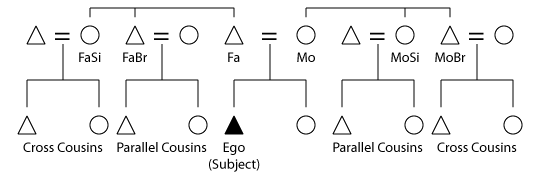
Parallel and cross cousins
In discussing consanguineal kinship in anthropology, a parallel cousin or ortho-cousin is a cousin from a parent's same-sex sibling, while a cross cousin is from a parent's opposite-sex sibling. So a parallel cousin is the child of the father's brother (paternal uncle's child) or the mother's sister (maternal aunt's child), while a cross cousin is the child of the mother's brother (maternal uncle's child) or of the father's sister (paternal aunt's child). Where there are unilineal descent groups in a society (i.e. matrilineal and/or patrilineal), one's parallel cousins on one or both sides will belong to one's own descent group, while cross cousins will not (assuming descent group exogamy).
Role
The role of cross cousins is especially important in some cultures. For example, marriage is promoted between them in the Iroquois system. Parallel cousins are occasionally the subject of promoted marriage, such as the preferential marriage of a male to his father's brother's daughter, common among some pastoral peoples. Such a marriage helps keep property within a lineage. On the other hand, parallel cousin unions in some cultures would fall under an incest taboo, since parallel cousins are part of the subject's unilineage whereas cross cousins are not.
Podcasts:

